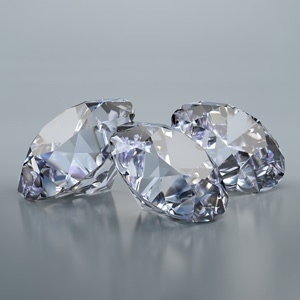
When the jewelry designer Katherine Jetter was 9 years old, she and her family left their home in Melbourne, Australia, so her father could pursue career opportunities overseas. “The older I got and the more time I spent in Europe, I always wondered, why don’t I see opals in the jewelry shops of London or Paris?” she tells JCK. “It seemed strange to me that the national gemstone of Australia was not seen that much outside of Australia.”

Jetter studied psychology at university in London and took a job in banking, but she could not resist the siren call of jewelry, nor of opals, in particular.
“As a young 24-year-old with no history in the jewelry industry and no backing, I persuaded my dad to take me to the opal mines [in the Australian state of New South Wales] and basically be my bodyguard,” the now 38-year-old designer recalls.
“I made friends with some of these small independent miners,” she adds. “They taught me the value of opals. I made it my unique expertise to be well versed, not just on how opals are set in jewelry but how they’re mined, how the rough is sourced, and how they’re cut depending on how they’re formed in the earth. That allowed me to pursue jewelry design from a different creative perspective.”

Keep in mind that this was the early 2000s, when the opal renaissance had not yet begun. Jetter was transitioning from living in London and attending GIA’s gemology program in New York, where she graduated in 2004. As she was preparing to form her own company, Jetter encountered the suspicion and superstition that have plagued opal for decades.
(In The Curious Lore of Precious Stones, published in 1919, the gemologist George Frederick Kunz attributed the opal’s jinxed reputation to a popular misreading of an episode in Sir Walter Scott’s 1829 novel, Anne of Geierstein, in which an opal’s loss of color was associated with death.)
Jetter’s timing was also somewhat jinxed. She established her eponymous design business in 2008, just as the global financial crisis was getting started. “But I was young and nimble and was able to react and survive,” she says. “People were like, ‘We like opals but we have very few customers coming in for them.’”

Jetter persisted. Her exotic jewelry, such as range of floral rings using carved opals as petals (including a Venus Flytrap ring!) was nothing like the inexpensive opal doublet rings jewelers would commonly see on the mass market. “I would tell them, ‘I’m not making opal jewelry, I’m making beautiful couture jewelry that happens to be set with opals,’” she says. “They needed to think about it differently.”

Then and now, Jetter strictly works with Australian and Mexican opals, leaning heavily on the black opals from Lightning Ridge that are considered the most collectible and desirable of all opals. “They’re found in pockets of soil, which is why they’re called ‘the gambler’s stone,’” Jetter says. “A guy could have a 10×10-foot claim and find nothing, while the guy in the claim next to him could strike it rich.”
Over the past 15 or so years, the designer has learned what makes her customers fall in love with the gems.
“American clients really love big statement pieces, they love purple hues,” she says. “For the American aesthetic, it’s more about creating a look than selling a really high value price per carat or color. I focused my pieces on making a couture look. I see the opals almost as a backdrop for the design I want to create. True to my DNA, nothing is traditional.”
That’s an understatement. After starting with her flower petal rings, Jetter moved on to incorporating boulder opal from the Australian state of Queensland into jewels that took advantage of the material’s signature ironstone host rock. (“Boulder opal lends itself well to pendants because it has the ironstone host rock to protect it,” Jetter says. “But from a pricing perspective, black opal is considered more valuable.”)

This year, the designer, whose The Vault boutique in Nantucket showcases her designs as well as those of her couture jewelry peers, introduced the Graffiti collection, including a black opal pendant (pictured at top) embraced by a hot pink rhodium heart and set with a 1.08-ct. heart-shaped pink tourmaline.
“I’ve now progressed to using gold finishes and enamel and setting techniques that allow me to bring out unique color ways,” says Jetter, referring to the electric blue, emerald green, and hot pink metal finishes she’s using in combination with the gems. “These are not your grandmother’s opals.”
She’s convinced that after a decade of rising interest in opal, the gem is ready for its closeup. “People need happy stones and happy color,” she says. “Opals have a very wearable, approachable aesthetic to them. They don’t feel as formal as diamonds. They feel better suited to our lifestyle now.”
And even though sourcing the gems in this year of supply chain disruptions has become more complicated, Jetter’s longstanding relationships in the opal community have buoyed her business. “I went back to my roots, to my tried-and-true opal dealers,” she says. “I went home, in a sense.”
Top: Graffiti pendant with 53.47-ct. Lightning Ridge opal in 18k gold with pink e-coating, 1.08-carat pink tourmaline on diamond station, double strand rose gold chain; $38,000; Katherine Jetter
- Subscribe to the JCK News Daily
- Subscribe to the JCK Special Report
- Follow JCK on Instagram: @jckmagazine
- Follow JCK on X: @jckmagazine
- Follow JCK on Facebook: @jckmagazine






